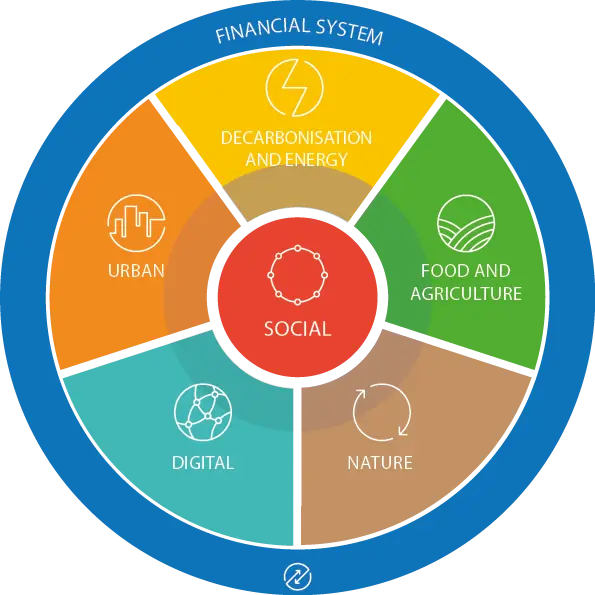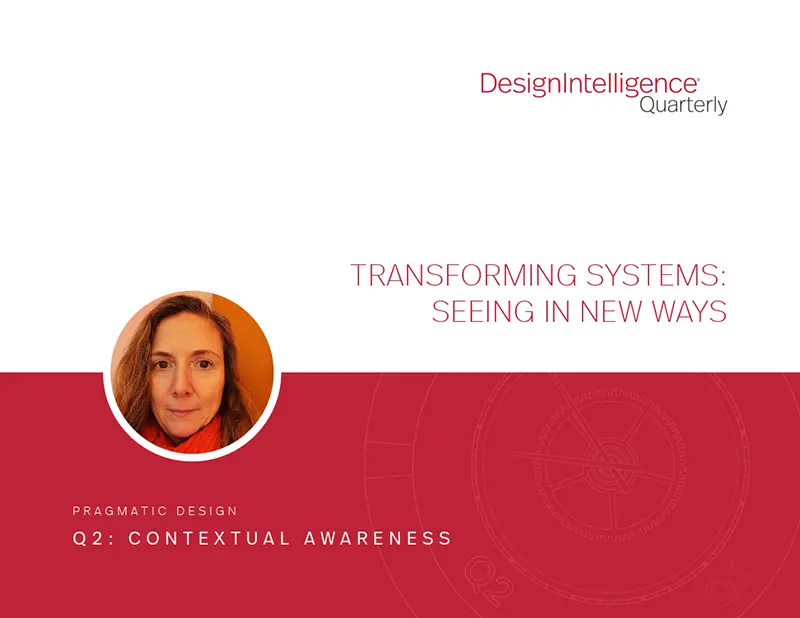Transforming Systems: Seeing in New Ways
by Francesca Birks
Design Strategist, Urban Futurist,
Researcher, Writer and Certified Facilitator
May 24, 2023
Francesca Birks suggests concurrent contexts, diverse perspectives and discursive design to build better futures.
“Let’s use our creativity to imagine new futures that can inspire hope. Equitable, sustainable, ethical, and culturally imaginative futures give us a better sense of direction to steer the things we build today. We now have the opportunity to embrace uncertainty as the real variable that it is and to take a proactive stance versus just reacting to it.”
- Kevin Bethune, “Reimagining Design”
Context is everything for architecture, and two kinds of “contextual” agendas shape its progress.
Since the beginning of humanity, as far back as 400,000 years ago with our Neanderthal predecessors, the human species has relied on our ability to scan our environments to survive. While back then this environmental awareness function proved essential for survival, contextual awareness continues to critically guide the continuation of the human species.
What has changed over the millennia is how we categorize threats and perceive risk and comfort. Our lists and rankings of threats, risks and comforts have expanded to become systemic alongside demographic growth, increased economic output and the introduction of new technologies. The result of all this human productivity in the 20th and 21st centuries is the creation of unprecedented complexity, which requires new methods for intelligently scanning our environments to plan for our future livelihood.
Systems Transformations
The acceleration of change and the emergence of multiple 21st-century crises require new ways of thinking about design. There is a dire need for new approaches given the widespread challenges we are facing as a society: the emergence of polycrisis – multiple crises unfolding at the same time – and the need for systemwide change to achieve the United Nations Sustainable Design Goals (UNSDG) 2030 goals. The World Benchmarking Alliance (WBA) has identified seven system transformations required to achieve the SDGs. They are:
- Social transformation.
- Agriculture and food system transformation.
- Decarbonization and energy system transformation.
- Nature and biodiversity transformation.
- Digital system transformation.
- Urban transformation.
- Financial system transformation.
Several of these systems are areas in which our industry can play an impactful role.

Concurrent Contexts, diagram adapted from World Benchmarking Alliance Diagram source: https://www.worldbenchmarkingalliance.org/seven-systems-transformations/
It is no longer sufficient to work in parallel silos. As a profession, we need to begin to think and act in connected ways. This seems like an ideal space for designers, architects and engineers to lead and create a model for integrated design practices. In all likelihood, learning to practice in connected, multi-contextual ways will ask us to explore new forms of collaboration with technologies like AI and the metaverse. But before we begin, we must ensure we clearly understand the problems we are solving as we consider which tools to use as well as potential unintended consequences our technology uses might have.
Design’s Why: An Evolving Role
In the Anthropocene age we are living in, it is worth asking ourselves: WHY are we designers? Who and what are we designing for? How will what we design impact society, the environment and future generations? Good design has the potential to solve societal problems but only once we shift our understanding of design from purely aesthetic or utilitarian purposes to understanding it as a means to achieve ideological change. This potential to transform broken systems has drawn me to work as a strategic designer in our field.
In our emerging future there are paths for many strands of design as we move forward as a profession. To focus our efforts, it is important to acknowledge their different perspectives and contributions. System design seeks better ways to manage the “increasingly complex and global interactions between people, products, and places.”1 Service design and social innovation are focusing on tactics and strategies to better serve human and environmental ecologies. Discursive design invites us to take a more thoughtful approach to industrial design and “asks us to consider how designed objects might be understood and leveraged for individual and social benefit by moving beyond a utilitarian intention”2 and instead to seize the opportunity for the design of objects to communicate ideas and invite reflection.
What these design approaches have in common is a belief that design can actively shape discourse and lead to the creation of better systems, services and societies. This is a development we should be excited about supporting throughout our industry and beyond.

Foresight Methods for Inclusive
Equitable Futures
In my experience as a Foresight practitioner, I use strategic foresight methodologies to engage different stakeholder perspectives and to practically assess alternative, evolving scenarios. These techniques have expanded my toolkit as a strategic designer and now facilitate conversations focused on exploring the impacts of emerging trends and for envisioning collective aspirational futures. Such exploratory work illuminates the challenges we face and the obstacles we need to overcome if we hope to reach our preferred North Star. To date, the Foresight practice and outlook have been limited because historically they have been primarily white, Western practices. While this has begun to shift in the last few years with the emergence of new voices and cultures in this traditionally narrow space, there is still more work to be done. I can’t help but wonder how our foresight methods will evolve and improve when we include a broader range of practitioners.
The Afrofuture strategist and artist Ingrid Lafleur3 has been exploring the creation of equitable futures using art, culture and emerging technology. In a recent talk at the Futures School, she shared the importance of being in conversation with global futures, which include Muslim, Chicano and other perspectives beyond Western-specific cultures. As we design and build our global collective futures, it is time we expand our conversations to include other non-Western-centric voices and celebrate their diverse perspectives, as they offer a richer array from which to choose the future we want to cocreate.
My own strategic design and foresight skills were shaped within the confines of a global engineering company – a culture with a tendency to jump into problem-solving quickly. In these complex times, emerging design cultures must arm us with the tools to comprehensively evaluate ambiguous problems before proposing definitive, time-bound solutions. Working through productive tensions will yield better outcomes. Rather than fear the conflict and treat it as a threat, we should reframe these productive tensions as essential explorations to ensure we choose the best path forward for most people.
The Road Ahead:
Divergent Diverse Teams Required
In a world undergoing immense change there is a clear need to work across silos, challenges and cultures in more integrated, collaborative ways. Whenever assembling a team, a panel or a project kickoff, look at the individuals you are considering. Do they all look and sound like you? If so, it’s time to reassess and reassemble the group. Time to add diverse thinkers, doers and designers that will look at the central problem and questions in different ways. The goal is not simply to generate monocultural or dichotomous thinking, but to provoke divergent, expansive thinking that generates new paths for achieving positive outcomes for people, places and the planet.
A Multicultural, Multifaceted Lens
My own perspective – being born 50% Canadian across the border from one of the most powerful post-World War II countries – provides a rich breeding ground for learning. Much of it from my older, at times slightly overconfident brother. Such geographic and birth placements were humbling yet instructive as I learned to be a more adept follower. At least, I hope so. Being born to parents from two different cultures also opened my eyes to more than one norm, or way of experiencing life, and made it less likely I would ever tend to fossilize norms based on one predominant belief system. These outcomes have proved to be a strategic advantage in an ever-complex context.

Three Tiers:
External, Organizational, Individual
Most of us don’t want to add to our daily to-do lists, but we may need to reshuffle our priorities to better meet the needs of the present and future moments. NYU clinical professor and research scientist of ethical systems Alison Taylor teaches a course titled “Leadership for the 21st Century: Delivering on Purpose and Profit.” Her class looks at three tiers of responsibility:
1) Look Out: Consider your social, environmental, ethical and moral obligations to broader society.
2) Look In: Create human-centered business practices within your organization.
3) Look Within: Develop the personal skills and perspectives needed to lead effectively and perform our design and foresight work more effectively attuned to individual, organizational and societal needs/requirements with a longer-term mindset.
Given the complexity of our world and the broadening list of risks and challenges, Taylor’s tiered approach to leadership and strategic design makes sense. It encourages us to explore external and organizational drivers as well as our own intrinsic motivations.
Over the last three years, as we rode the pandemic’s tumult, I have discovered this inner work and reflection to be just as important as the scanning of external drivers. While our Neanderthal predecessors had little time to consider much beyond their immediate physical safety, in our current climate and coming decades new technologies will continue to give rise to new risks. As we continue to develop our skills at scanning contextual and cultural awareness, we will need to consider their implications to our society, organizations and ourselves.
Francesca Birks is a design strategist, urban futurist, researcher, writer and certified facilitator with 20 years of experience working in the built environment. For over a decade she led the foresight and design strategy team in the Americas at global engineering consultancy Arup and more recently served as the global insights leader at global architecture studio Woods Bagot. While at Arup she authored the demographic “drivers of change cards” and helped launch the ventures function in North America. From Big Tech to the World Expo in Dubai, her work has taken her across the globe and has exposed her to a variety of sectors and cultures and a shared commitment to strategically designing a better future.
FOOTNOTES:
1,2 See: “Discursive Design,” Bruce Tharpe’s work on discursive design and inviting a more self-reflective approach to design,
and its intended consequences on society. https://mitpress.mit.edu/9780262038980/discursive-design/
3 Ingrid Lafleur, https://www.ingridlafleur.com/ and https://www.theimaginarium.love/


